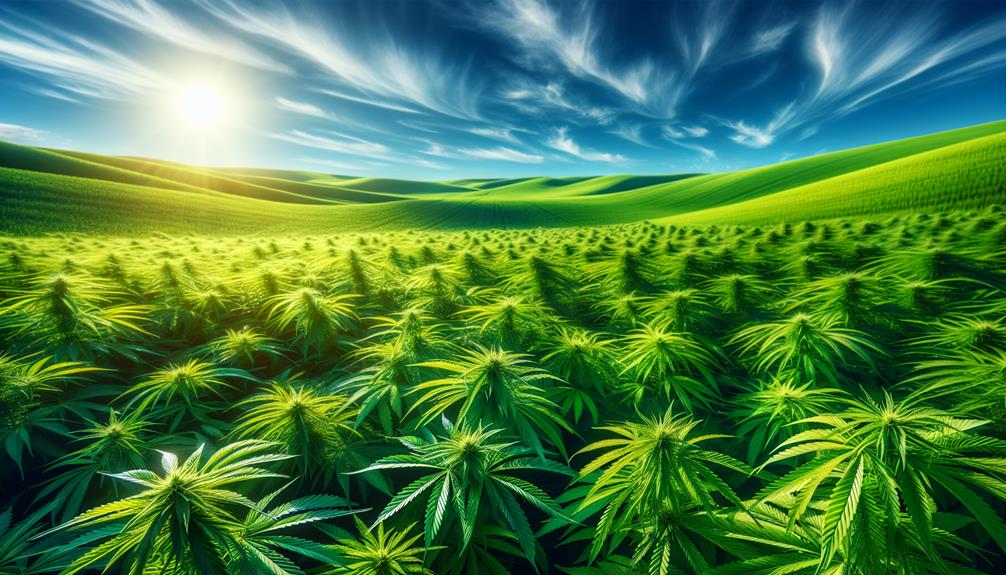I've always wondered about the origins of hemp, and it turns out it first popped up in Central Asia around 8,000 BCE. People began growing it mainly for its practical uses. Over time, it made its way to places like Europe and later on to the New World, finding a role in various industrial applications. What's really cool is that hemp contains components like CBD and essential amino acids, making it not just useful but also beneficial for health. Hemp's versatility is just the tip of the iceberg; there's so much more to uncover about how different regions use it today.
Table of Contents
Key Takeaways
- Hemp originates from Central Asia, where it has been cultivated since around 8,000 BCE.
- It was historically used by ancient civilizations, including the Chinese, for textiles, ropes, and paper.
- The crop spread from Asia to Europe and later to the New World, adapting to various climates and uses.
- China remains the leading producer of hemp, using sustainable agricultural methods.
- Global cultivation has expanded due to hemp's versatility in industrial applications and its low THC content.
Historical Origins
Hemp has been a staple crop since around 8,000 BCE, originally grown in Central Asia for its diverse applications. Its journey from ancient times to modern days is pretty fascinating. Back in the day, folks in ancient China were already spinning this versatile plant into textiles and twisting it into ropes. They even crafted the earliest forms of paper from hemp. Talk about a multi-tasker, right?
As people got hip to how useful hemp was, its cultivation spread across Europe and eventually made its way to the New World with the early settlers. In the United States, hemp became a big deal for producing textiles and paper, among other things. It was practically a go-to plant for all sorts of industrial uses.
Now, what really makes hemp a superstar are its components like Cannabidiol (CBD) and essential amino acids, which are super beneficial for us. Plus, it's packed with polyunsaturated fatty acids, including linoleic acid. These elements make hemp products not just useful but pretty health-friendly too. From its historical origins to today, hemp, or Industrial Hemp as we call it now, has proven its worth time and again.
Botanical Profile
Delving into the botanical profile of Industrial hemp, it's clear that this plant, Cannabis sativa subsp. sativa, boasts a rich genetic diversity originating from Central Asia. Hemp, unlike its cousin that's high in THC, is specially cultivated for its low THC levels, making it ideal for a variety of non-psychoactive uses.
Diving deeper, hemp seeds are a powerhouse when it comes to health benefits. They're a rich source of fatty acids, including the essential alpha-Linolenic acid, which is fantastic for heart health. Not just that, cannabidiol (CBD), a biologically active compound found in hemp, is gaining fame for its potential in easing various health conditions without the high associated with marijuana.
Furthermore, hemp seeds contribute a hefty dose of insoluble fiber, crucial for digestive health. This aspect of hemp makes it not only a nutritional supplement but also a functional food.
Understanding these botanical and nutritional profiles helps us appreciate hemp beyond its industrial applications. It underscores the plant's versatility and its growing role in health and nutrition sectors. Thus, the genetic uniqueness of hemp not only influences how it's cultivated but also how it can be an integral part of our wellness routines.
Global Cultivation Practices
I'll now explore how different countries have adopted unique hemp cultivation methods over the years. Starting in Central Asia, hemp has journeyed across the globe, adapting to various climates and farming techniques. In China, which currently leads in global hemp production, there's a strong push for sustainable methods that respect environmental concerns. They've really honed in on maximizing the biological activities of hemp to boost both yield and quality.
Moving over to the USA, the 2018 Farm Bill was a game-changer, legalizing hemp with a THC content of less than 0.3%. This has sparked a wave of interest in both the health benefits of hemp and its potential as a cash crop. American farmers are increasingly turning to hemp, intrigued by its low THC levels and high Cannabidiol (CBD) potential, which is celebrated for its health benefits.
Globally, the resurgence in hemp production can be attributed to its diverse applications, from Hemp seed protein, which is gaining fame as a superfood, to sustainable farming practices that appeal to environmentally conscious consumers. Each region tailors its approach to local conditions, emphasizing either the health benefits of hemp, its environmental advantages, or both.
Industrial Uses
Let's explore the various industrial uses of hemp, which range from construction materials to health supplements. The hemp plant has been around for thousands of years, serving multiple purposes in societies worldwide. Today, it's used in over 25,000 products! Imagine that—the same plant that gives us eco-friendly construction materials also pops up in our daily supplements.
One of the coolest things about hemp is its fiber. This part of the plant is super strong and is used to make ropes, reinforcement products, and even eco-friendly paper. With growing awareness about sustainability, hemp's popularity in construction is skyrocketing, thanks to its ability to improve soil quality and prevent erosion.
Now, let's talk about hemp seeds. These little guys are packed with nutrition and have been used in food and beverages for centuries. The oil extracted from these seeds, known as hemp seed oil, is a hit in both the kitchen and skincare routines. Plus, there's a lot of research on the health benefits of Cannabidiol (CBD), another product derived from hemp, which is making waves in the Life Sciences field.
Legal Status and Regulations
Throughout the world, the legal status of hemp hinges on its THC content, with a common cap set at 0.3% to distinguish it from marijuana. This threshold is crucial because it defines what's recognized as industrial hemp under legal regulations, avoiding the psychoactive effects associated with higher levels of THC found in marijuana. The distinction is based on the presence of THC and the enzyme acid synthase, which plays a key role in THC production.
Here's why understanding these regulations matters:
- Farmer's Peace of Mind: Farmers growing industrial hemp can do so without the fear of legal repercussions, provided they adhere to THC content limits and ensure their crop doesn't cross the legal threshold.
- Consumer Safety: Testing protocols are in place to guarantee that products derived from hemp, like Cannabidiol (CBD), are safe and non-intoxicating.
- Innovation in Agriculture: With clear legal frameworks, researchers and cultivators can explore the benefits of Cannabis sativa L., enhancing crop variety and utility.
- Economic Growth: Licensing requirements ensure a regulated market, promoting a stable and profitable hemp industry.
These points underscore the importance of stringent, yet supportive, legal frameworks that benefit everyone from the farmer to the consumer.
Frequently Asked Questions
Is Hemp and Marijuanas the Same Plant?
Hemp and marijuana aren't the same; they're different subspecies of the Cannabis plant. Hemp's got low THC, making it non-intoxicating, while marijuana's high THC content is used recreationally and medicinally.
What Is the Main Source of Hemp?
The main source of hemp is the Cannabis sativa plant, specifically the low-THC subspecies. It's grown for its fiber, seeds, and cannabinoids, used in various industries like textiles and health products.
Where Is Hemp Naturally Found?
I've learned that hemp is naturally found in Central Asia. It thrives in temperate climates and has spread to various parts of Asia, Europe, and North America through both cultivation and natural growth.
What Is Made From Hemp Plant?
I've learned that the hemp plant is incredibly versatile. It's used to make textiles, biodegradable plastics, nutritional supplements, and even CBD oil, all of which are part of a sustainable, eco-friendly industry.
- Cotton vs. Polyester vs. Poly-Cotton: Which Fabric Is Best for You? - June 23, 2025
- What Is Cotton Polyester Fabric? a Complete Beginner’s Guide - June 23, 2025
- Is Crepe Fabric Sustainable? A Look at Eco-Friendly Options - June 23, 2025







